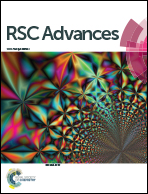Chemical bond in FexTiSe2 intercalation compounds: dramatic influence of Fe concentration
Abstract
The introduction of 3d transition metals into the van der Waals gaps of titanium dichalcogenides with layered structures gives rise to an interesting family of intercalation compounds, the physical properties of which differ substantially from those of the host compound due to “host–guest” and “guest–guest” interactions, resulting in ordering of the intercalated metal. FexTiSe2 is one of the most intriguing of such intercalation compounds due to its special electronic and magnetic properties. In this paper, the influence of the iron concentration on the crystal structure, electronic structure and chemical bond in the FexTiSe2 intercalation compounds is studied across a wide composition range (0 ≤ x ≤ 0.50) within the homogeneous region of the system. Photoelectron, resonance photoelectron and X-ray absorption spectroscopy methods were combined with thermodynamic electromotive force (EMF) measurements for the Li|Li+|FexTiSe2 cell in order to monitor the Fermi energy concentration dependence. The electronic structure changed substantially as the Fe content increased. A proposed model of the FexTiSe2 electronic structure transformation implies that iron atoms form Ti–Fe–Ti bonds at x < 0.40, but that Fe–Fe bonds prevail at x ≥ 0.40 when nanoscale iron chains appear in the van der Waals gap.



 Please wait while we load your content...
Please wait while we load your content...